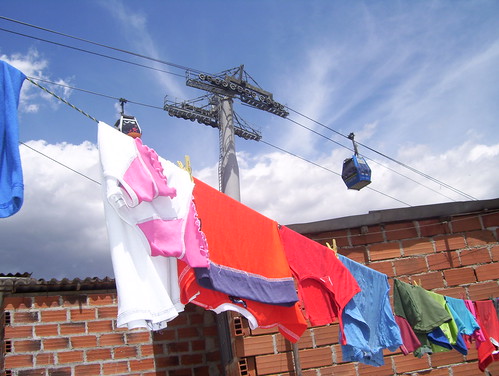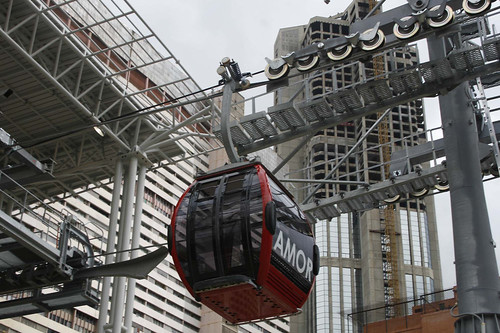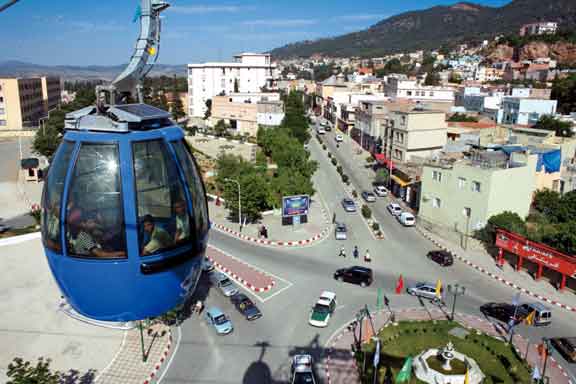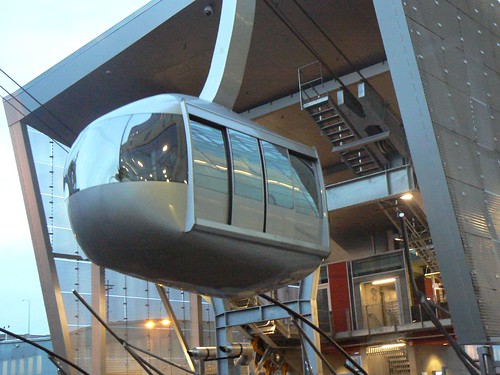Others might disagree with my selection, but if you’re new to the world of Cable Propelled Transit (CPT) and Urban Gondolas, these are the 7 aerial systems you need to know about:
1. The Medellin Metrocables
Really and truly, this is the place it all started. Medellin has three Metrocables already in operation with plans for several more. If you are to understand CPT and Urban Gondolas, this is the place to start. Learn more about the Medellin Metrocables here.
2. The Caracas Metrocables
The successor to the Medellin systems. Caracas is aggressively planning/building several more CPT lines. The systems are part of a dramatic social rebuilding process and stations double as community centers, markets, gymnasiums, etc. This social mandate added greatly to the cost of the system, making it appear as though the transit system was more than 10 times the cost than it actually was. Learn more about the Caracas Metrocable here.
3. The Roosevelt Island Tram
New York’s Roosevelt Island Tram (RIT) has a wonderful history. Originally planned as a stop-gap measure in the 1970’s, the RIT was to carry new residents of Roosevelt Island to Manhattan via Aerial Tram but only until a subway connection was established. However, once the subway connection was established, residents still enjoyed the Tram’s view and experience. Ridership did, however, dwindle due to lack of Fare Integration. Once a deal was struck to remedy this problem, ridership increased greatly. The system is undergoing a major renovation and the Aerial Tram will be replaced with a Funifor style system this fall. Learn more about the Roosevelt Island Tram here.
4. The Koblenz Rheinseilbahn
As described before the Koblenz, Germany’s Rheinseilbahn has been designed as a demonstration piece for how Urban Gondolas could best fit into the urban environment. Their “Urban Concept” vehicles are absolutely inspired. It’s a shame the systems are more Toy For Tourist than fully-integrated CPT system, but it’s a step in the right direction. Learn more about the Koblenz Rheinseilbahn here.
5. Algerian Gondolas
Having never seen these systems personally, it’s hard to comment on their importance. Word on the street, however, is that three different Urban Gondola systems are in operation and a few more are under construction. Their geo-political isolation, strong uptake and complete lack of publicly available information makes these systems a tantalizing prospect for adventurous researchers. Learn more about the Algerian Gondolas here.
6. The Funivia Del Renon
Owing to its Northern Italian heritage, it’s no wonder this system in Bolzano oozes style. It is a stunning example of how to blend station architecture into the existing urban fabric. Too bad the capacity is so curiously low wait times can reach up to 30 minutes. The Funivia uses a 3S style technology, which as any reader of The Gondola Project knows is the highest capacity technology around. Why then does the Funivia only carry 500 pphpd? Learn more about the Funivia Del Renon here.
7. Portland Aerial Tram
From a design perspective, this system is a necessity. It’s beautiful, with elegant swooping towers and custom-designed cabins. And while the system experiences double the ridership than originally expected, the system has one inherent flaw: It’s an Aerial Tram. The question you should turn over your head every time you encounter this system is this: Why did planners opt for an Aerial Tram rather than a Gondola-based system? Furthermore, it’s complex history of poor planning, last minute changes, and lack of community engagement makes it a fascinating case study of how not to build a CPT system. Learn more about the Portland Aerial Tram here.








12 Comments
Which system on the list is unimportant?
Scott,
I don’t follow your question. What do you mean exactly? As I see it, all are important. They’re not in any particular order. (Except maybe for Medellin).
Sorry, I was making a bit of a joke. your title is: The 7 Most Important Aerial Cable Systems In The World (For Various Reasons). There are 8 systems listed, hence i concluded you must view one as unimportant.
Your are welcome to delete my comments on this thread.
Scott,
I have no problem leaving your comments as testament to the fact that counting is not my strong suit.
@Scott B & Steven Dale
There are 7 systems, just two are named #7 and none were bestowed the title of 6.
Man, it really shouldn’t take me two separate edits to spot that problem.
😛
other than that, nice article. Good for the occasional reader.
Nice write up Steven. But, I would have to replace the Algerian Gondolas or Bolzano, with the Lisbon Gondola (Teleférico Lisboa).
Yes it is a ‘toy for tourists’, but it is an urban gondola that operates in a completely flat environment. The system displaces two myths instantly – gondolas can operate along flat ground, and gondolas can blend in the urban environment!! Its been around since 1998, it is located in a developed country, and is a moderately attractive mono-cable system – minimalistic, simple, purposeful in its appearance.
And we all know (unfortunately), the biggest limitation to the uptake of gondola technology is inadequate knowledge and misconceived perceptions about what it can, and can’t do. Even the simple stuff!. Lisbon is a significant marketing tool! It helps people visualize the technology in a flat urban environment (maybe their own) – it conveys simple messages, but important ones.
Ryan,
Good point. But I don’t think we have to replace one system with the LIsbon system. We can simply include it. Maybe it should be the 8 most important aerial cable systems in the world?
Could we go with an even 10 systems? I’d add Peak2Peak. Sure it’s not urban (at all), but it does demonstrate an amazing feat of engineering, showing that cable is versatile and can do extraordinary things (like be unsupported for vast expanses).
We can have as many systems as we want in this list. Telluride, Lisbon and Peak 2 Peak would all be important.
If it was to be 10 – Telluride Gondola could perhaps squeeze in – Connecting Telluride and Mountain Village in the US. Provides free transportation between the two towns – still it has a significant tourism component. So in terms of assisting the technology into the urban market, its impact has been limited.
Other ones of note are Ngong Ping (Hong Kong) and Maokong (Taiwan) – both relatively complex (long distances, turns, multiple stations etc). But not the best implementation or safety record. Funchal Gondola (Portugal) is interesting also, it does travel through an urban residential area for some distance, but serves a tourist function.